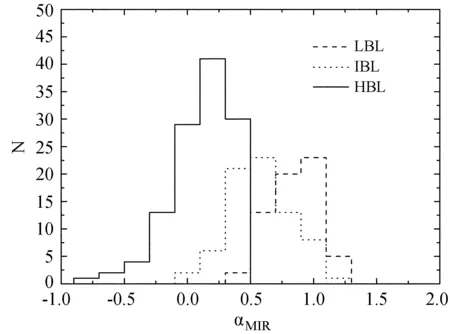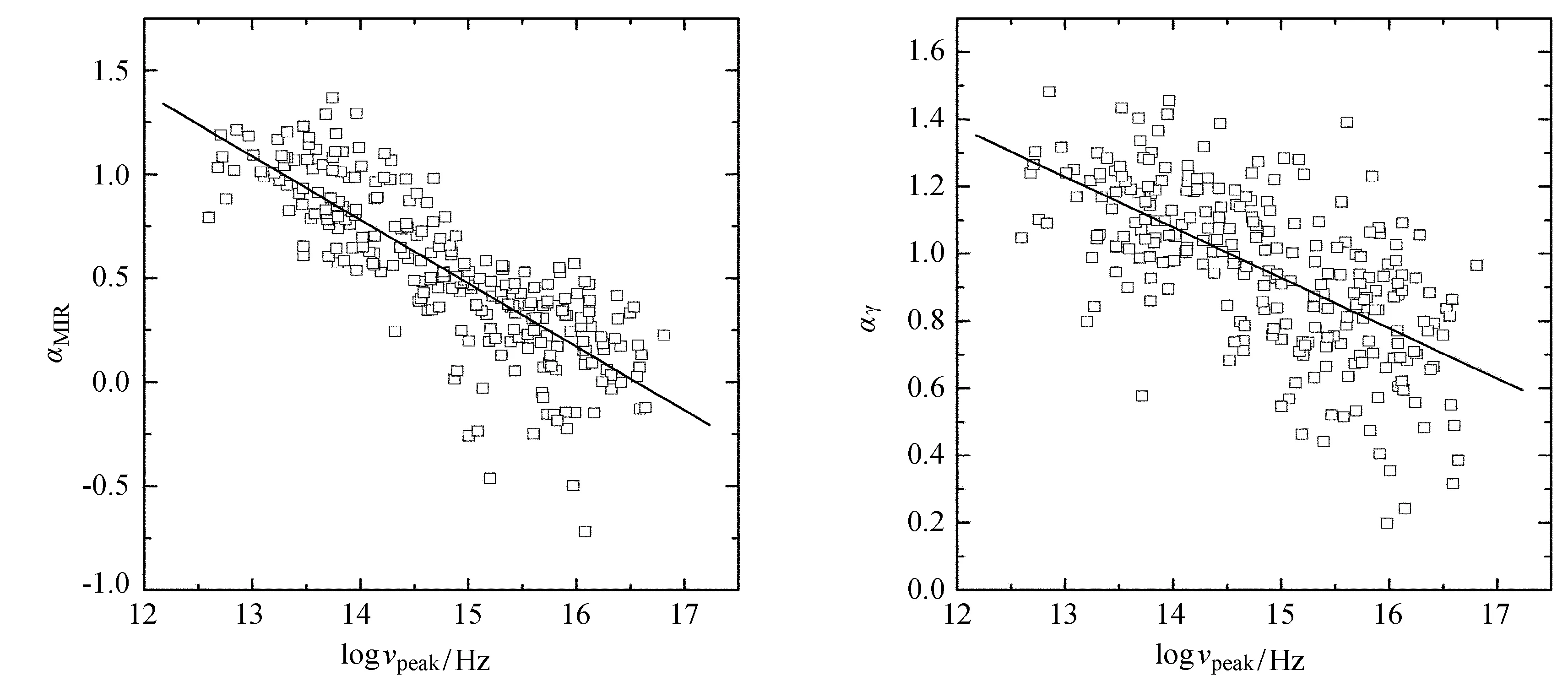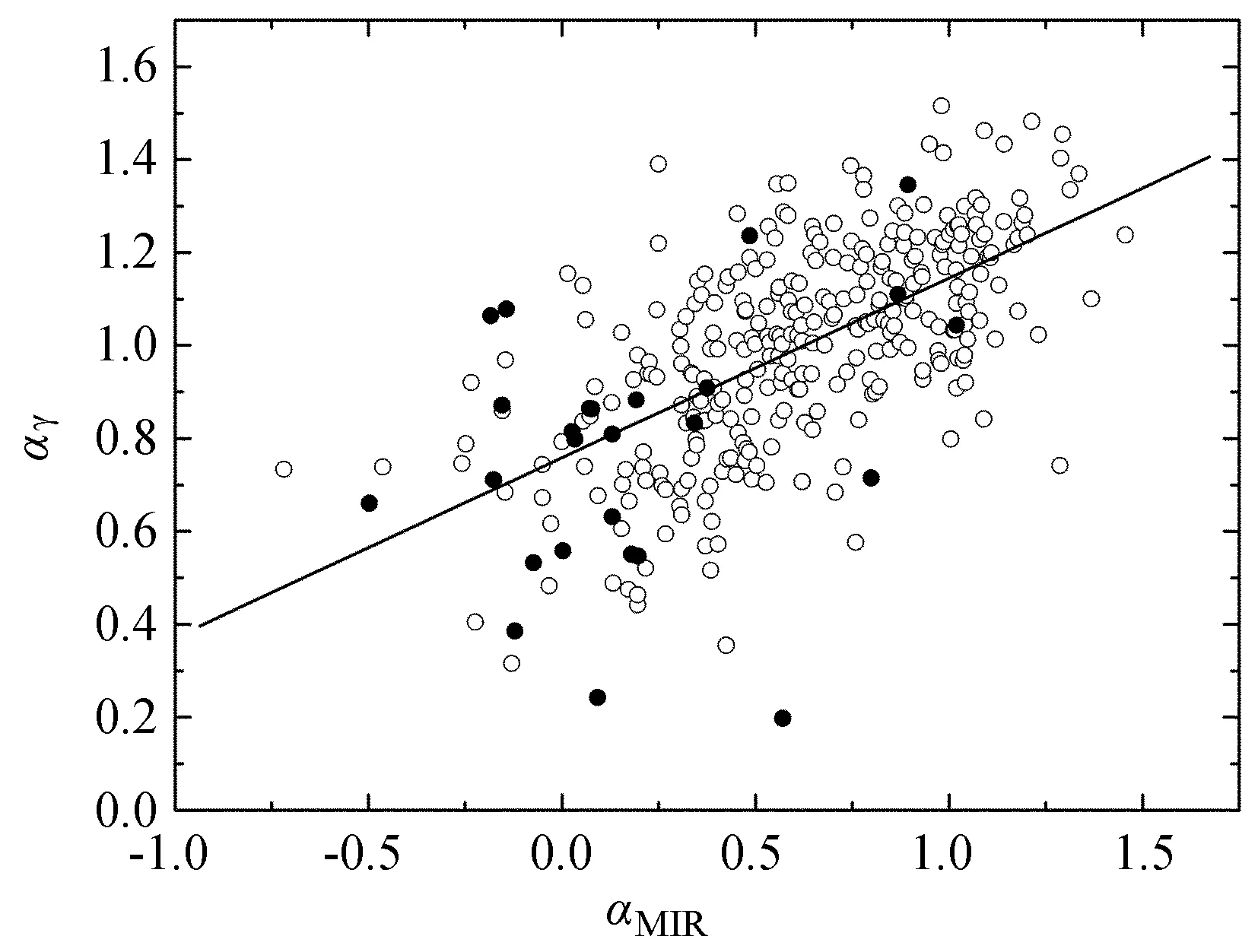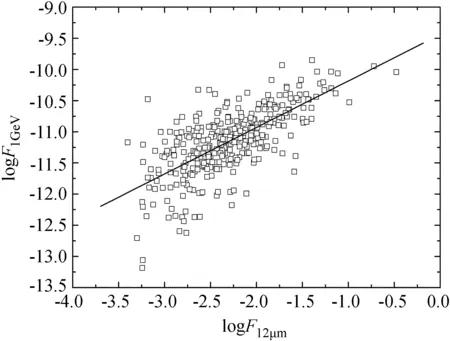Revisiting the Correlation between γ-Ray and Mid-Infrared Fluxes of the BL Lac Objects Detected by the FERMI Satellite
2013-12-16MaoLisheng
Mao Lisheng
(Physics Department, Yunnan Normal University, Kunming 650500, China, Email: maols@126.com)
1 Introduction

BL Lacs and Flat Spectrum Radio Quasars (FSRQs), collectively named as blazars, constitute the most interesting and enigmatic class of extragalactic γ-ray sources[3-5]. Comptonization is believed to be responsible for the γ-ray emission from BL Lacs and FSRQs, and it has two types according to the origins of the soft seed photons: the external Comptonization (EC) and the synchrotron self-Comptonization (SSC)[6]. It has been suggested that the SSC may be responsible for the γ-ray radiation from BL Lacs while the EC dominates over the SSC for FSRQs[7-9].
Recently D′Abrusco et al. (2012)[10]studied the correlation between γ-ray emission and MIR emission in blazars detected by the FERMI satellite in its first 24-month survey and by the Wide-Field Infrared Survey (WISE)[11]in its first 105 days (covering 57% of all the sky). The All-Sky WISE data were released to the public in March 2012, allowing us to derive the largest avalible sample of BL Lacs with both γ-ray and MIR observational data. In this paper, we revisit the correlation between the γ-ray emission and the MIR emission in the BL Lacs detected by the FERMI.
2 Sample and Data
The Second FERMI/LAT AGN Catalog (2LAC) includes 1,017 significant γ-ray sources located at high Galactic latitudes (|b|>10°) and statistically associated with AGN (Ackermann et al. 2011, hereafter A11)[12]. However, some of these are affected by data-analysis issues and some are associated with multiple AGN. We define a clean sample which includes 886 AGN. Among these, 395 are BL Lacs, 310 are FSRQs, 157 are blazar candidates of unknown optical-emission types, and 24 are AGN of other types. We focus on the 395 BL Lacs.
The WISE mapped the sky at 3.4μm, 4.6μm, 12μm, and 22μm (hereafter, W1 through W4) in 2010 with an angular resolution of 6.1″, 6.4″, 6.5″, and 12.0″ in the four bands, respectively. The 5σ point source sensitivities for the four bands are better than 0.08mJy, 0.11mJy, 1mJy, and 6 mJy in unconfused regions on the ecliptic. The WISE All-Sky Release includes all data taken during the full cryogenic-mission phase, from January 7, 2010 to August 6, 2010. These data were processed with calibration and reduction algorithms better than the Preliminary Data Release (covering 57% of the sky) in April 2011. The All-Sky Release data products include a Source Catalog containing positional and photometric information for over 563 million objects detected in the WISE images. This Source Catalog can be accessed via the IRSA interface (http://irsa.ipac.caltech.edu/Missions/wise.html).
The A11 gives the J2000 positions of the 395 BL Lacs used (see Table 3 therein). We use these position values to search for the WISE counterparts. Following Massaro et al. (2011, hereafter M11)[13]we adopt a search radius of 2.4″. When the angular separation between the position of a BL Lac and that of a WISE source is less than 2.4″, we take the WISE source as the MIR counterpart of the BL Lac. As a result, 337 of the 395 BL Lacs have unique WISE counterparts, with the WISE detection rate at about 85.3%. With 26 exceptions, each of these BL Lacs has photometric magnitudes with error estimates in the W1, W2, W3, and W4 bands. The 26 BL Lacs have the magnitudes in the W1 through W3, but only have upper limits on the W4 magnitudes. Of the 337 BL Lacs with WISE counterparts found, 63, 74, 120, and 80 are LBL, IBL, HBL, and BL Lacs of unknown spectral types, respectively.
3 Results
3.1 [3.4]-[4.6]-[12]μm Color-Color Diagram
Authors of M11 found that the blazars in their sample (corresponding to a 57% sky coverage) lie in a distinct region (i.e., the WISE Blazar Strip, or WBS) in the [3.4]-[4.6]-[12]μm color-color plot, and are clearly separated from other extragalactic sources with radiation in the MIR band dominated by thermal emission. This implies that the MIR emission of blazars is dominantly non-thermal. The WBS can be used to extract new blazar candidates, identify blazars of uncertain types, and search for the counterparts of unidentified γ-ray sources[14-16]. Using the WISE observational data of the all-sky 337 BL Lacs, we show the distribution of BL Lacs in the [3.4]-[4.6]-[12]μm color-color diagram (Fig.1). It is obvious from Fig.1 that the great majority of BL Lacs fall in the WBS and lie near the power-law line (PLL) (with only five clear outliers). This result indicates that their MIR radiation is dominantly non-thermal, i.e. mainly from synchrotron emission.
3.2 Spectral-Index Correlation
As suggested by Reference [18], an IR spectral index is an important parameter to describe the synchrotron emission. Here we derive the MIR spectral indices of the 337 BL Lacs having WISE counterparts. We first convert the magnitudes of the W1 through W4 bands to flux densities using the zero-magnitude fluxes (306.681Jy, 170.663Jy, 29.0448Jy, and 8.2839Jy for the W1 through W4 bands, respectively) from Reference[11]. We notice that the Galactic extinction at a WISE wavelength is negligible[13]. We then apply the equation logFν=-α logν+β to fit the converted flux densities, where ν is the frequency,Fνis the flux density, and α and β are fitting parameters. A linear fit gives the MIR spectral index (αMIR) and its uncertainty (σMIR). In the fitting we take into account the uncertainties of flux densities. For the 26 BL Lacs having only upper limits for their W4 magnitudes, we use the data of the W1 through W3 bands to deriveαMIRandσMIR.


Fig.1 The [3.4]-[4.6]-[12]μm color-color diagram for the 337 BL Lacs. The region between the two dashed lines is the WBS. The dotted line represents the power-law line (derived using the method in [17])

Fig.2 The MIR spectral-index (αMIR) distributions of LBLs, IBLs, and HBLs


Fig.4 presents the correlation betweenαMIRandαγ. A linear fit gives the following tight correlation:
αγ=(0.76±0.02)+(0.39±0.03)αMIR
(1)
with the Pearson coefficientR=0.62 and the random-chance probabilityP<10-4. For the subclasses of LBLs, IBLs, HBLs, and BL Lacs of unknown spectral types, the Peason coefficients are 0.33, 0.37, 0.26, and 0.40, with the random-chance probabilities of 8.0×10-3, 1.0×10-3, 5.0×10-3, and 2.5×10-4, respectively. These results show that a significant (99% level) corrlation exists betweenαMIRandαγfor each subclass separately.
3.3 Flux Correlation
Reference [20] gives the 0.1-100GeV flux values (S25, in units of erg cm-2s-1) of the 337 BL Lacs. We convertS25to the monochromatic flux at 1GeV,F1GeV, according to the formula in Thompson et al. (1996)[21]:
.
(2)
Fig.5 shows the correlation between the logarithm of 1GeV flux (γ-ray) and that of 12μm flux (MIR). A linear fit gives the following result:
logF1GeV=(-9.44±0.10)+(0.75±0.04)logF12μm
(3)
with the Pearson coefficientR=0.69 and the random-chance probabilityP<10-4. For the subclasses of LBLs, IBLs, HBLs, and BL Lacs of unknown spectral types, the Peason coefficients are 0.42, 0.68, 0.69, and 0.38, with the random-chance probabilities of 7.1×10-4, <10-4, <10-4, and 5.0×10-4, respectively. These results show that (a) a correlation between MIR and γ-ray fluxes also exists for each subclass, and (b) the correlations tend to be stronger from LBLs to HBLs.

Fig.4 The correlation betweenαMIRandαγ. The solid circels represent the 26 BL Lacs whoseαMIRvalues are derived from the W1 through W3 magnitudes. The open circels represent 311 BL Lacs whoseαMIRare derived from the W1 through W4 magnitudes

Fig.5 The correlation between the logarithm of 1GeV flux and that of 12μm flux
4 Discussion and Conclusions
In this paper we search for the WISE counterparts of BL Lacs in the 2LAC Clean Sample. Out of 395 BL Lacs therein 337 were detected by the WISE with the detection rate of about 85.3%. As recently shown in M11, the blazars, with synchrotron emission dominating their radiation, lie in a distinct region (WBS) in the [3.4]-[4.6]-[12]μm color-color diagram, and appear to be clearly separated from abundant non-synchrotron emission dominated WISE sources. Here we find that nearly all of the 337 BL Lacs fall in the WBS, giving a tentative evidence that their MIR emission is dominantly non-thermal. Moreover, Fig.1 shows that these BL Lacs lie in a region even more confined than the general WBS shown in Fig.1 of M11. Such a narrow region in the infrared color-color diagram is further denominated as the WISE Gamma-ray blazar Strip (WGS) in the work by Massaro and coauthors[10,14-16].
We derive the MIR spectral indices (αMIR) of the 337 BL Lacs based on the WISE observational data. It is shown that LBLs have a larger average MIR spectral index than HBLs, and that of IBLs is between those of LBLs and HBLs. BothαMIRandαγare strongly anti-correlated with the logarithm of synchrotron peak frequency. These results indicate that BL Lacs show an MIR or γ-ray spectral-index sequence. The gradual trends ofαMIRandαγpoint towards an underlying commonality among LBLs, IBLs, and HBLs in the sense that BL Lacs form a unique population with the same type of emission processes taking effect in a range of physical conditions, so as to make the distribution of the BL Lac population continuous rather than bimodal or trimodal[2, 22]. Chen, Shan, and Gao (2006)[23]compared the near-infrared (NIR) spectral indices of radio-selected BL Lacs (RBLs) and X-ray selected BL Lacs (XBLs). They found that the former group has a larger average NIR spectral index than the latter. It is well known that most RBLs are LBLs and most XBLs are HBLs. In view of this, our results are consistent with those of Chen, Shan, and Gao (2006).
Exploring the relation between the γ-ray emission and the low-energy (radio to X-ray) emission in blazars can provide important insights into the soft photons constituting the observed γ-rays. The relations between radio, optical, X-ray, and γ-ray radiations of blazars have been widely discussed[24-26]. In contrast, the correlation between infrared and γ-ray radiations has been studied only by a few authors. This could be mainly due to the lack of γ-ray and infrared observations for a sufficiently large number of blazars. The difficulty has now been overcome by the availability of FERMI and WISE data. Zhang and Xie (1997)[27]reported a strong correlation between the γ-ray (above 100MeV) luminosity and the far-infrared (60μm) luminosity for 17 blazars. They suggested that the γ-ray and far-infrared luminosities are both beamed and there is a direct link between them. Xie et al. (1998)[28]found that there is a strong correlation between the γ-ray flux densities and NIR flux densities in the low and high states for 15 BL Lacs. Zhang et al. (2003)[29]found that there is a strong correlation between NIR spectral indices and γ-ray spectral indices. Mao (2011)[30]explored these two types of correlations for 260 BL Lacs detected by the FERMI. It was shown that there are strong correlations between NIR and γ-ray radiations in BL Lacs. Very recently, using the WISE Preliminary Data Release (57% sky coverage) D′Abrusco et al. (2012) found that there are significant correlations between γ-ray and MIR fluxes and betweenαMIRandαγ. In this paper, using the All-Sky WISE data we revisit such correlations. We verify with higher confidence the strong correlation betweenαMIRandαγas well as that between 12μm and 1GeV fluxes. Our results and those in References [10] and [27-30] imply a direct link between the γ-ray emission and the infrared emission for γ-ray prominent BL Lacs.
It is well known that both the SSC model and the EC model predict a close correspondence between synchrotron and Compton flux densities in the observed spectra of blazars as due to the conversion of loss of energy of relativistic electrons in common region(s) to both types of radiations. In fact, BL Lacs show null or weak emission lines, and yield no observed thermal emission from the accretion disk; these features can be interpreted by the scarcity of gas surrounding the accretion disk and low efficiency of transforming gravitational energy to radiation. BL Lacs also lack observational signatures of the dust torus in the MIR band[31]. Consequently, spectra of BL Lacs are often effctively interpreted as pure SSC radiation, i.e., synchrotron emission (from infrared to soft X-ray) from highly relativistic electrons inside the jet, and inverse Compton upscattering (radiating in the MeV-TeV energy range) by the electrons in the same regions on seed photons of the synchrotron radiation. The tight γ-ray-MIR correlation found in this paper is consistent with the SSC model and probably shows common spatial origins of γ-ray and MIR emission.
[1]Urry C M, Padovani P. Unified Schemes for Radio-Loud Active Galactic Nuclei[J]. Publications of the Astronomical Society of the Pacific, 1995, 107(715): 803-845.
[2]Padovani P, Giommi P. A sample-oriented catalogue of BL Lacertae objects[J]. Monthly Notices of the Royal Astronomical Society, 1995, 277(4): 1477-1490.
[3]Hartman R C, Bertsch D L, Bloom S D, et al. The third EGRET catalog of high-energy gamma-ray sources[J]. The Astrophysical Journal Supplement Series, 1999, 123(1): 79-202.
[4]Abdo A A, Ackermann M, Ajello M, et al. Bright active galactic nuclei source list from the first three months of the fermi large area telescope all-sky survey[J]. The Astrophysical Journal, 2009, 700(1): 597-622.
[5]Abdo A A, Ackermann M, Ajello M, et al. The first catalog of active galactic nuclei fetected by the fermi large area telescope[J]. The Astrophysical Journal, 2010, 715(1): 429-457.
[6]Böttcher M. Modeling the emission processes in blazars[J]. Astrophysics and Space Science, 2007, 309(2): 95-104.
[7]Dondi L, Ghisellini G. Gamma-ray-loud blazars and beaming[J]. Monthly Notices of the Royal Astronomical Society, 1995, 273(3): 583-595.
[8]Paggi A, Massaro F, Vittorini V, et al. SSC radiation in BL Lacertae sources, the end of the tether[J]. Astronomy and Astrophysics, 2009, 504(3): 821-828.
[9]Lister M L, Aller M, Aller H, et al. γ-ray and parsec-scale jet properties of a complete sample of blazars from the MOJAVE program[J]. The Astrophysical Journal, 2011, 742(1): 27-51.
[10]D′Abrusco R, Massaro F, Ajello M, et al. Infrared colors of the gamma-ray-detected blazars[J]. The Astrophysical Journal, 2012, 748(1): 68-81.
[11]Wright E L, Eisenhardt P R M, Mainzer A K, et al. The wide-field Infrared survey explorer (WISE): mission description and initial on-orbit performance[J]. The Astronomical Journal, 2010, 140(6): 1868-1881.
[12]Ackermann M, Ajello M, Allafort A, et al. The second catalog of active galactic nuclei detected by the fermi large area telescope[J]. The Astrophysical Journal, 2011, 743(2): 171-207.
[13]Massaro F, D′Abrusco R, Ajello M, et al. Identification of the infrared non-thermal emission in blazars[J]. The Astrophysical Journal, 2011, 740(2): 48-52.
[14]Massaro F, Paggi A, D′Abrusco R, et al. Searching for γ-ray blazar candidates among the unidentified INTEGRAL sources[J]. The Astrophysical Journal Letters, 2012, 750(2): 35-40.
[15]Massaro F, D′Abrusco R, Tosti G, et al. Unidentifed gamma-ray sources: hunting gamma-ray blazars[J]. The Astrophysical Journal, 2012, in press (arXiv: 1203.3801).
[16]Massaro F, D′Abrusco R, Tosti G, et al. The wise gamma-ray strip parameterization: the nature of the gamma-ray active galactic nuclei of uncertain type[J]. The Astrophysical Journal, 2012, 750(2): 138-147.
[17]Chen P S, Shan H G. Infrared photometric study of type II quasars[J]. Monthly Notices of the Royal Astronomical Society, 2009, 393(4): 1408-1422.
[18]Chen P S, Shan H G. Infrared spectral observation of eight BL Lac objects from the spitzer infrared spectrograph[J]. The Astrophysical Journal, 2011, 732(1): 22-26.
[19]Abdo A A, Ackermann M, Agudo I, et al. The spectral energy distribution of fermi bright blazars[J]. The Astrophysical Journal, 2010, 716(1): 30-70.
[20]The Fermi-LAT Collaboration. Fermi large area telescope second source catalog[J]. The Astrophysical Journal Supplement Series, 2012, 199(2): 31-76.
[21]Thompson D J, Bertsch D L, Dingus B L, et al. Supplement to the second EGRET catalog of high-energy gamma-ray sources[J]. The Astrophysical Journal Supplement, 1996, 107: 227-237.
[22]Nieppola E, Tornikoski M, Valtaoja E. Spectral energy distributions of a large sample of BL Lacertae objects[J]. Astronomy and Astrophysics, 2006, 445(2): 441-450.
[23]Chen P S, Shan H G, Gao Y F. On the difference between the X-ray selected and the radio selected BL Lac objects in the near infrared[J]. New Astronomy, 2006, 11(8): 557-566.
[24]Ghisellini G, Tavecchio F, Foschini L, et al. The radio-γ-ray connection in Fermi blazars[J]. Monthly Notices of the Royal Astronomical Society, 2011, 413(2): 852-862.
[25]Wagner S J. Fast flares of blazars during gamma-ray observations: Optical-gamma-ray correlations[J]. A&AS, 1996, 120: 495-498.
[26]Wang J C, Luo Q H, Xie G Z. Spectral relation between X-rays and gamma-rays for blazar high-energy emission[J]. The Astrophysical Journal Letters,1996, 457: 65-68.
[27]Zhang Y H, Xie G Z. Correlation between Gamma-ray and Far-infrared Luminosity for EGRET-detected Sources[J]. Astronomy and Astrophysics, 1997, 317: 393-396.
[28]Xie G Z, Zhang X, Bai J M, et al. Gamma-ray and near-infrared emission from gamma-ray-loud blazars[J]. The Astrophysical Journal, 1998, 508(1): 180-185.
[29]Zhang X, Cheng K S, Zhao G, et al. Correlation between the gamma-ray and the near-infrared emissions from gamma-ray-loud blazars in the low state[J]. Astrophysics and Space Science, 2003, 286(3): 323-331.
[30]Mao L S. 2MASS observation of BL Lac objects II[J]. New Astronomy, 2011, 16(8): 503-529.
[31]Plotkin R M, Anderson S F, Brandt W N, et al. The lack of torus emission from BL Lacertae objects: an infrared view of unification with WISE[J]. The Astrophysical Journal, 2012, 745(2): 27-32.
